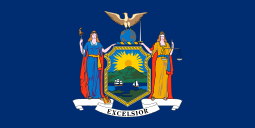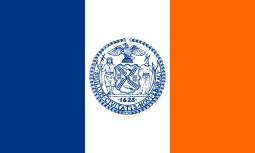Bronx–Whitestone Bridge
| Bronx-Whitestone Bridge | |
|---|---|
|
View of the Bronx-Whitestone Bridge from Queens. | |
| Coordinates | 40°48′03″N 73°49′50″W / 40.80083°N 73.83056°WCoordinates: 40°48′03″N 73°49′50″W / 40.80083°N 73.83056°W |
| Carries |
6 lanes of |
| Crosses | East River |
| Locale | New York City (Throggs Neck, Bronx – Whitestone, Queens) |
| Other name(s) | Whitestone Bridge |
| Maintained by | MTA Bridges and Tunnels |
| Characteristics | |
| Design | Suspension bridge |
| Total length | 3,770 feet (1,150 m) |
| Longest span | 2,300 feet (700 m) |
| Clearance above | 14 feet 6 inches (4.4 m) |
| Clearance below | 134 feet 10 inches (41.1 m) |
| History | |
| Construction cost | $19.7 million[1] |
| Opened | April 29, 1939 |
| Statistics | |
| Daily traffic | 105,718 (2012)[2] |
| Toll | As of March 22, 2015, $8.00 (cash); $5.54 (New York State E-ZPass) |
 Bronx-Whitestone Bridge  Bronx-Whitestone Bridge  Bronx-Whitestone Bridge | |
The Bronx–Whitestone Bridge (colloquially referred to as the Whitestone Bridge or simply the Whitestone) is a suspension bridge in New York City that crosses the East River and connects the boroughs of Queens on Long Island, and the Bronx on the United States mainland via Interstate 678. The bridge was designed by Othmar Ammann and opened to traffic with four lanes on April 29, 1939.[3]
The Bronx–Whitestone Bridge is owned by New York City and operated by the MTA Bridges and Tunnels, an affiliate agency of the Metropolitan Transportation Authority.
History



Construction
The idea for a crossing between the Bronx and Whitestone, Queens had come as early as 1905. At the time, residents around the proposed area of the bridge protested construction in fear of losing the then-rural character of the community. In 1929, however, the Regional Plan Association had proposed another bridge from the Bronx to northern Queens to allow motorists from upstate New York and New England to reach Queens and Long Island without traveling through the traffic-ridden communities of western Queens.[4] On February 25, 1930, influential planner Robert Moses proposed a Ferry Point Park-Whitestone Bridge as a part of his Belt Parkway system around Brooklyn and Queens.
As the 1930s progressed, Moses found his bridge increasingly necessary to directly link the mainland to the 1939 New York World's Fair and to LaGuardia Airport (then known as North Beach Airport). In addition, the Whitestone Bridge was to provide congestion relief to the Triborough Bridge. The New York Legislature approved Moses' plan in April 1937. Moses had raised controversy when he quickly decided to demolish seventeen homes in the Queens community of Malba. Moses argued such measures were necessary to complete the bridge on schedule. The RPA had also said that the Whitestone Bridge should have rail connections, or at least be able to accommodate them in the future, but had no allies on the project, to Moses' relief.
Designer Othmar Ammann had several plans for the bridge that would keep construction on its tight schedule. The two 377-foot (115 m) towers were constructed in a short 18 days and were the first to have no diagonal cross bracing. Unlike other suspension bridges, the Whitestone Bridge did not have a stiffening truss system. Instead, 11-foot (3.4 m) I-beam girders gave the bridge an art deco streamlined appearance.
Opening
The Bronx–Whitestone Bridge opened on April 29, 1939, in festivities led by then-Mayor of New York City Fiorello H. La Guardia.[3] The bridge featured pedestrian walkways as well as four lanes of vehicular traffic, which carried 17,000 vehicles per day during the year 1940. The toll was 25 cents. The new "Whitestone" or Type 41 lamp post was later used in many other projects.[5] The 2,300-foot (700 m) center span was the fourth longest in the world at the opening. However, Ammann's plan to use I-beam girders proved to be a poor one after the collapse of the original Tacoma Narrows Bridge in Washington (known as Galloping Gertie for the effect wind had on the structure). The Bronx–Whitestone Bridge used the same general design as the Tacoma Narrows Bridge. The Narrows Bridge employed an 8-foot (2.4 m) deep girder system, much like the 11-foot (3.4 m) I-beam girders of the Whitestone Bridge. To mitigate the risk of failure from high winds, eight stay cables (two per tower per side) were installed for added stability in 1940.
Starting in 1943, the pedestrian walkways were removed from the bridge allowing for vehicular traffic expansion by the creation of two more vehicular lanes. The project's primary goal was to reinforce the bridge with trusses after the Tacoma Narrows Bridge disaster. The four lanes of roadway traffic were widened to six lanes and 14-foot (4.3 m) high steel trusses were installed on both sides of the deck to weigh down and stiffen the bridge in an effort to reduce oscillation. These trusses detracted from the former streamlined looking span. In 2003, the Metropolitan Transit Authority restored the classic lines of the bridge by removing the stiffening trusses and installing fiberglass fairing along both sides of the road deck. The lightweight fiberglass fairing is triangular in shape giving it an aerodynamic profile “that slices the wind as it passes over the bridge."[6][7] The removal of the trusses and other changes to the decking cut the bridge's weight by 6,000 tons, some 25% of the mass suspended by the cables.[8]
Originally built to connect the Hutchinson River Parkway in the Bronx to the Whitestone Parkway in Queens, the Bronx–Whitestone Bridge was redesignated as an interstate highway, Interstate 678, in the late 1950s. The approaches to the bridge were soon after converted to Interstate Highway standards. The Whitestone Parkway became the Whitestone Expressway, and part of the Hutchinson was converted to an expressway. They now share the I-678 designation with the bridge itself.
Major repairs
The Metropolitan Transportation Authority planned to spend $286 million in bridge renovations, which started in August 2001. These renovations, which are still in progress, include removing the cable stays installed in the 1940s, removing the 14-foot (4.3 m) trusses (which proved to be too heavy for the bridge's suspension cables, which were not designed to hold such weight), adding mass dampers to stabilize the bridge deck, repainting the two towers and the deck of the bridge, upgrading the lighting systems (including the beacons of the bridge and bulbs), and installing variable message signs. Replacing the deck of the bridge and assisting in lightening the deck by 6,000 tons was projected to be done by 2008.[9] The bridge remains in service during overhaul, but a reduced number of lanes lead to traffic backups and signs suggesting use of the Throgs Neck Bridge. Trucks over 40 tons have been prohibited from using the span since 2005.
Construction has been ongoing as of 2009 to upgrade the bridge. Changes including a third supporting pier, the removal of the median barrier, the removal and replacement of the old roadway with a new superstructure, and demolition of the old supporting piers are being undertaken at a cost of $192.8 million.[10]
Tolls
Starting on March 22, 2015, the cash tolls $8.00 per car or $3.25 per motorcycle. E‑ZPass users with transponders issued by the New York E‑ZPass Customer Service Center pay $5.54 per car or $2.41 per motorcycle.[11]
Public transportation
The bridge carries two MTA Regional Bus Operations routes, the Q44 SBS, operated by MTA New York City Transit, and the Q50 Limited (formerly known as the QBx1), operated by the MTA Bus Company.
After the removal of the sidewalks starting in 1943, bicyclists were able to use QBx1 buses of the Queens Surface Corporation, which could carry bicycles on the front-mounted bike racks. However, since the Metropolitan Transportation Authority absorbed the bus routes formerly operated by Queens Surface, the bike racks have been eliminated.[12] Bicyclists are now forced to detour to the Triborough Bridge or possibly try hitchhiking across, which is illegal[13] and considered very dangerous. Whether a bikeway or walkway will be constructed on the bridge in the future is uncertain.
Road connections
The Bronx–Whitestone Bridge assists I-678 in crossing the East River. From the Queens side, the Whitestone Expressway carries I-678 to the bridgehead. The Cross Island Parkway meets up with the Whitestone Expressway 1/2 mile before the bridge.
On the Bronx side, the bridge leads directly into the Bruckner Interchange, which serves as the northern terminus of I-678, which is where the Cross Bronx Expressway (I-95), Bruckner Expressway (I-278 & I-95), Hutchinson River Parkway, and the Cross Bronx Expressway extension (I-295) meet. The segment of I-678 between the bridge and the Bruckner Interchange is a depressed freeway.
See also
-
 Bridges portal
Bridges portal -
 New York portal
New York portal -
 New York City portal
New York City portal - Lists of crossings of the East River
- List of bridges documented by the Historic American Engineering Record in New York
References
- ↑ "NYC MTA - M15 SelectBusService - Park It! Guides".
- ↑ "2012 New York City Bridge Traffic Volumes" (PDF). Retrieved 2014-09-23.
- 1 2 "WHITESTONE SPAN OPENED BY MAYOR; New Bronx-Long Island Link Hailed as Symbol of City's Never-Ending Progress". The New York Times. April 30, 1939. Retrieved November 4, 2007.
- ↑ "Highway Loop in Plan Skirts Busy Centers". The New York Times. May 30, 1929. p. 12. Retrieved 2010-05-29.
- ↑ Walsh, Kevin (2013-08-01). "Whitestone Lamps". Greater Astoria Historic Society. Retrieved 22 February 2015.
- ↑ A New Look for a Classic Bridge, MTA Newsroom, Bridges & Tunnels. Accessed November 2, 2007.
- ↑ Roth, Alisa (October 12, 2003). "A Onetime Thing of Beauty Gets a Little Prettying Up". The New York Times. Retrieved April 4, 2010.
- ↑ Chan, Sewell (February 18, 2005). "A Bridge Too Fat". The New York Times. Retrieved July 28, 2008.
- ↑ Preliminary Capital Program for 2005–2009, Metropolitan Transportation Authority, dated July 29, 2004.
- ↑ , MTA Bridges and Tunnels Construction Improvements
- ↑ "Toll Information". MTA Bridges & Tunnels. Retrieved February 25, 2015.
- ↑ "Bronx-Whitestone Bridge (I-678)" (PDF). Transportation Alternatives. Section 4-04(e)(2). Retrieved April 4, 2010.
- ↑ "New York City Department of Transportation Traffic Rules" (PDF). New York City Department of Transportation. December 17, 2009. Section 4-04(e)(2). Retrieved April 4, 2010.
External links
| Wikimedia Commons has media related to Bronx-Whitestone Bridge. |
- Official website
- Historic American Engineering Record (HAER) No. NY-308, "Bronx-Whitestone Bridge, Spanning East River between Whitestone, Queens & the Bronx, Bronx County, NY", 11 photos, 1 photo caption page
- NYCRoads.com Bronx-Whitestone Bridge
- Bronx-Whitestone Bridge at Structurae
